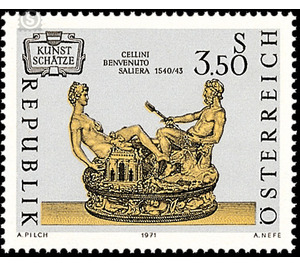art treasures - Austria / II. Republic of Austria 1971 - 3.50 Shilling
Theme: Devices, Items & Instruments
| Country | Austria / II. Republic of Austria |
| Issue Date | 1971 |
| Face Value | 3.50 |
| Color | grey yellow |
| Printing Type | combination printing |
| Stamp Type | Commemorative |
| Item Type | Stamp |
| Chronological Issue Number | 700 |
| Chronological Chapter | OOS-OE2 |
| SID | 930767 |
| In 61 Wishlists | |
The merger of the old Imperial Treasury and the Ambras Collection in the 19th century saw the creation of the "Collection of Industrial Artifacts" and finally the Collection of Plastics and Applied Arts. She already received her accommodation in the Kunsthistorisches Museum, where she still lives today. The brand motif of the third special postage stamp from this series shows the "Saliere", a princely tableware, namely a salt barrel. The whole representation of the salt barrel is an allegory of the earthly world: in the figure of Tellus and Neptune, the earth and the sea are represented, and in these divine forms at the same time also man. Then the beasts, the fruits and the flowers of the earth and the creatures of the seas, then the four winds that indicate the spatial dimensions of the globe, and finally the four times of the day. From an artistic point of view, Benvenuto Cellini's "Saliera" is one of the most perfect masterpieces of Renaissance goldsmithing.


